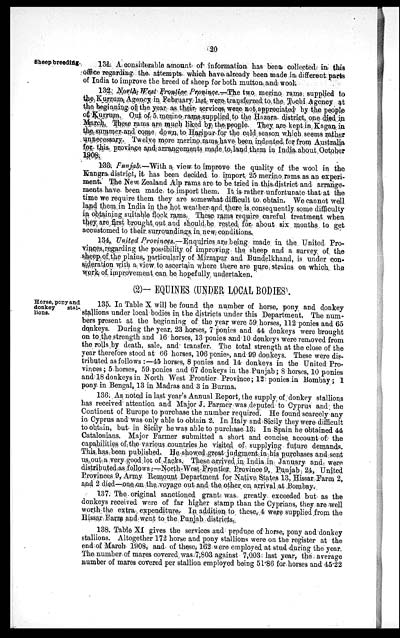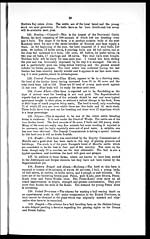Medicine - Veterinary > Civil Veterinary Departments > Annual administration report of the Civil Veterinary Department of India > 1907-1908 > Part A - Provincial administration
(31) Page 20
Download files
Individual page:
Thumbnail gallery: Grid view | List view

20
Sheep breeding.
131. A considerable amount of information has been collected in this
office regarding the attempts which have already been made in different parts
of India to improve the breed of sheep for both mutton, and wool.
132 North-West Frontier Province.—The two merino rams supplied to
the Kurrum Agency in February last were transferred to the Tochi Agency at
the beginning of the year as their services were not appreciated by the people
of Kurrum. Out of 5 menino rams supplied to the Hazara district, one died in
March. These rams are much liked by the people. They are kept in Kagan in
the summer and come down to Haripur-for the cold season which seems rather
unnecessary. Twelve more merino rams have been indented, for from Australia
for this province and arrangements made to land them in India about October
1908.
133. Punjab.—With a view to improve the quality of the wool in the
Kangra district, it has been decided to import 25 merino rams as an experi-
ment. The New Zealand Alp rams are to be tried in this district and arrange-
ments have been made to import them. It is rather unfortunate that at the
time we require them they are somewhat difficult to obtain. We cannot well
land them in India in the hot weather and there is consequently some difficulty
in obtaining suitable flock rams. These rams require careful treatment when
they are first brought out and should be rested for about six months to get
accustomed to their surroundings in new conditions.
134. United Provinces.—Enquiries are being made in the United Pro-
vinces regarding the possibility of improving the sheep and a survey of the
sheep of the plains, particularly of Mirzapur and Bundelkhand, is under con-
sideration with a view to ascertain where there are pure strains on which the
work, of improvement can be hopefully undertaken.
(2)— EQUINES (UNDER LOCAL BODIES.
Horse, pony and
donkey stal-
lions.
135. In Table X will be found the number of horse, pony and donkey
stallions under local bodies in the districts under this Department. The num-
bers present at the beginning of the year were 59 horses, 112 ponies and 65
donkeys. During the year, 23 horses, 7 ponies and 44 donkeys were brought
on to the strength and 16 horses, 13 ponies and 10 donkeys were removed from
the rolls by death, sale, and transfer. The total strength at the close of the
year therefore stood at 66 horses, 106 ponies, and 99 donkeys. These were dis-
tributed as follows:—45 horses, 8 ponies and 14 donkeys in the United Pro-
vinces; 5 horses, 59 ponies and 67 donkeys in the Punjab; 8 horses, 10 ponies
and 18 donkeys in North West Frontier Province; 12 ponies in Bombay; 1
pony in Bengal, 13 in Madras and 3 in Burma.
136. As noted in last year's Annual Report, the supply of donkey stallions
has received attention and Major J. Farmer was deputed to Cyprus and the
Continent of Europe to purchase the number required. He found scarcely any
in Cyprus and was only able to obtain 2. In Italy and Sicily they were difficult
to obtain, but in Sicily he was able to purchase 13. In Spain he obtained 44
Catalonians. Major Farmer submitted a short and concise account of the
capabilities of the various countries he visited of supplying future demands.
This has been published. He showed great judgment in his purchases and sent
us out a very good lot of Jacks. These arrived in India in January and were
distributed as follows:—North-West Frontier Province 9, Punjab 24, United
Provinces 9, Army Remount Department for Native States 13, Hissar Farm 2,
and 2 died—one on the voyage out and the other on arrival at Bombay.
137. The original sanctioned grant was greatly exceeded but as the
donkeys received were of far higher stamp than the Cyprians, they are well
worth the extra expenditure. In addition to these, 4 were supplied from the
Hissar Farm and went to the Punjab districts.
138. Table XI gives the services and produce of horse, pony and donkey
stallions. Altogether 172 horse and pony stallions were on the register at the
end of March 1908, and of these, 162 were employed at stud during the year.
The number of mares covered was 7,803 against 7,003 last year, the average
number of mares covered per stallion employed being 51.86 for horses and 45.22
Set display mode to: Large image | Zoom image | Transcription
Images and transcriptions on this page, including medium image downloads, may be used under the Creative Commons Attribution 4.0 International Licence unless otherwise stated. ![]()
| Permanent URL | https://digital.nls.uk/75509543 |
|---|




